Production Notes - Live And Let
Die
Diamonds Are Forever had been another huge hit for Eon's Bond franchise,
but producers Harry
Saltzman and Albert
R. Broccoli had been aware
all along that Sean Connery's return to the fold had been a temporary
one, the star agreeing to just the one film before again moving
on to pastures new. So before they could begin production on their
next film, Live And Let Die, the hunt would have to begin again
for a new Bond.
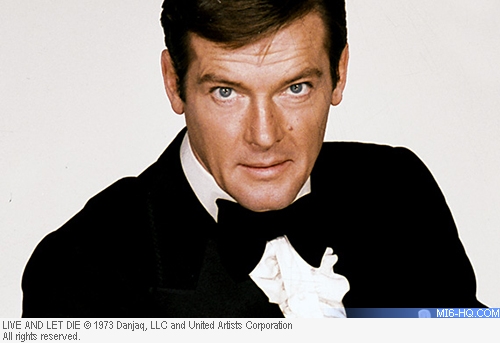
Above: Roger Moore as
James Bond 007
|
But even before Saltzman and Broccoli began grappling with the
major headache of who should replace Connery, pre-production was
well underway. Tom Mankiewicz returned to write his second script
for the Bond series and, as was becoming increasingly the case,
took very little from Fleming's novel save the title, a handful
of characters and the very basic plot. While he gutted the novel
of its most cinematic elements, returning director Guy Hamilton
and production designer Syd Cain headed for Jamaica in March to
scout out likely locations.
|
Back in the UK, Saltzman and Broccoli dabbled with the
idea of not using an actor at all for their new Bond, but
looking for someone from the armed services who might be
able to take on the part.
They took out advertisements
in army magazines asking "Are you 007?" and waited
to see what would happen. Unfortunately, the reply they
got was from Equity, the actor's union, who objected most
strongly and demanded that EON drop their plans.
So Saltzman and Broccoli began searching for a suitable
actor to take over from Connery. By June 1972, their short
list had been reduced to a handful of likely candidates,
among them future TV Sherlock Holmes Jeremy Brett, and
future Bond villain Julian Glover (who would later play
Kristatos in For Your Eyes Only (1981)).
Leader of the pack at this point appeared to be Michael
Billington, well known to British TV viewers as one of
the stars of Gerry Anderson's UFO (1969) and The Onedin
Line. Broccoli was a close friend of Billington's and was
asked to screen test no less than seven times. He was eventually
passed over for the part, though he did appear in a Bond
film later - he played the small role of Sergei in The
Spy Who Loved Me (1977).
|
|
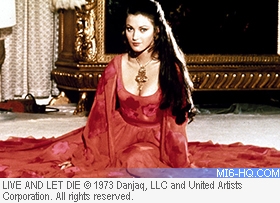
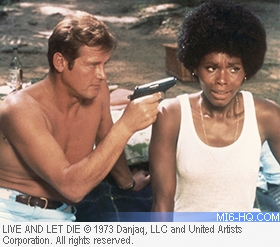
Above: The leading ladies of "Live
And Let Die" - Jane Seymour (top) and
Gloria Hendry.
|
Twice before, Roger
Moore's name had been in
the frame for Bond and twice he'd been rejected by Saltzman and
Broccoli due to
his
commitments elsewhere. In 1972, he was contracted to Lew Grade's
The Persuaders! and it again looked like he was going to lose
the chance to play 007. But The Persuaders! proved to be unpopular
with the public, particularly in the States where it failed to
compete with Mission: Impossible against which it was
scheduled
and Moore (who Broccoli had first met some time before in a casino
in London's Curzon Street) suddenly found himself released from
his five-year contract. The timing was impeccable - in August
1972, Moore was offered a three film deal with United Artists.
|
Moore was the first Englishman to have played the most
quintessentially English of characters in the official
series - Connery was Scottish; George
Lazenby, an Australian;
Timothy Dalton, a Welshman; and Pierce
Brosnan is Irish.
Daniel Craig become the second Englishman when he was cast
as 007 #6 in 2005.
Jane Seymour took the role of tarot priestess Solitaire
only after the decision was made not to cast her as a black
woman as she was written in the script. Similarly, black
actress Gloria Hendry took the role of CIA agent Rosie
Carver after she was changed from "a beautiful, dazed
white girl." Seymour won the role over Catherine Deneuve,
the producers' original choice, after Broccoli had seen
her on TV's The Onedin Line.
Shooting began at the beginning of October and took place
largely in the States and not in Jamaica as had originally
been planned.
The Dixieland funeral was shot first,
on Charter and Durmaine Streets in the French Quarter of
New Orleans. On Friday 13th October, Roger Moore tackled
the
demanding power boat chase through a bayou some 30 miles
outside New Orleans. |
|
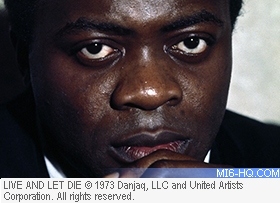
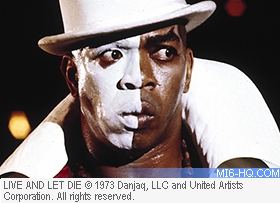
Above:
Kananga (AKA Mr Big) and the mysterious Baron Samedi.
|
By early November, the production ran into its first problem.
Moore had earlier sustained a minor leg injury which he had now
recovered from, only to fall foul of a long-standing kidney stone
problem, forcing Hamilton to re-schedule the shoot around his
star's temporary absence.
Seymour joined the Bond team hot off the set of The Onedin Line
and was exhausted. Indeed she was so tired that she arrived with
a note from her father-in-law, Richard Attenborough, asking Hamilton
to go easy on her. She was joined by David Hedison, an old friend
of Moore's, as the fourth incarnation of Felix
Leiter, a role
he was to reprise 16 years later in Licence
to Kill (1989).
On 29 November, the crew packed their bags and headed for Jamaica
aboard charter flights arranged at just 24 hours notice by the
redoubtable Charles Russhon. The crew settled in to the Sans Souci
Hotel in Ocho Rios and were soon working at the 300-acre crocodile
farm owned by stuntman Ross Kananga, who had already contributed
his surname to the production (Mankiewicz liked it so much he
used it to christen his villain) and was now about to contribute
both his farm and his skills. Other Jamaican locations included
Runaway Caves and the Green Grotto lake.
On 7 December, Roger Moore was able to put into practice his
three months of bus driver training he'd undertaken under the
supervision of London Transport instructor Maurice Pratchett.
Between them, Moore and Pratchett staged the spectacular stunt
in which Bond shears off the top of a double decker by driving
it under a low bridge.
|
Shortly before Christmas, the Jamaican shooting wound
up and the cast and crew took a well earned holiday. While
they were away, Maurice Binder assembled the first of the
film's teaser trailers to whet the appetite of the public
both in Britain and in the States. As the New Year approached,
cast and crew re-assembled at Pinewood where the production
had taken over eight of the stages. This time round, there were some question marks over which
of the regular supporting cast were going to return. The
script made no mention of Q so for the first time since his
debut in From Russia With Love (1963), so Desmond Llewelyn
would not be appearing.
Lois Maxwell was on hand as the ever-adoring Moneypenny,
but the recent tragic death in a fire of Bernard Lee's wife,
Gladys Merredew, left some doubt as to whether the long-running
M actor would be available.
Kenneth More, a good friend of Roger Moore, offered to appear
as M but only if his fee was
passed on to the grieving Lee. In the end, Lee turned up
for his short appearance, M venturing out of his office to
visit 007 at his apartment.
With studio filming over, the
crew set of for New York where the Harlem scenes were filmed. |
|

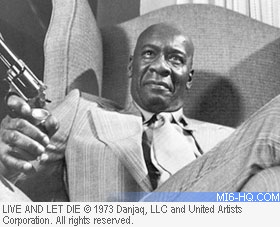
Above: Director Guy Hamilton sets up a shot in New Orleans (top), Geoffrey
Holder as Tee Hee.
|
With shooting finished and editing under way,
it was time for the soundtrack to be recorded and for the first
time in the
series,
John Barry was not to wave the baton. Instead, the score was
written by former Beatles producer George Martin, with the title
song performed by Paul McCartney, who had been originally penciled
in for the theme to Diamonds Are Forever (1971) before being
replaced by Shirley Bassey. The film marked a reunion for McCartney
Martin, this being the first time the pair had worked together
since
the Abbey Road album in 1969.
Live And Let Die had its British premiere at the series' other
spiritual home (after Pinewood Studios, of course), the Odeon
in London's Leicester Square on 4 July 1973. The film did reasonably
well at the box office, but it marked a noticeable drop in takings
again from the renewed financial success of Diamonds Are Forever
(1971) - with US admissions of just 20.1 million, the film came
in rather behind the 1960s extravaganzas.